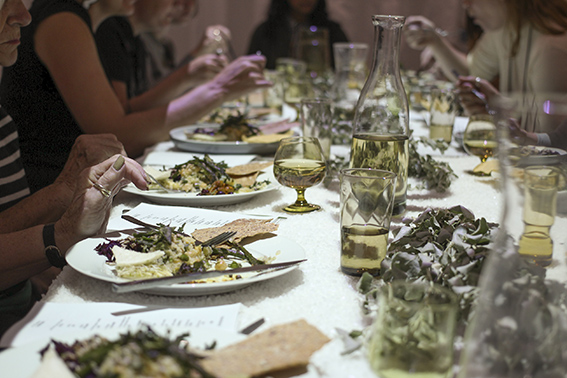‘The only rock we eat’ in ‘Bruised: Art, Action and Ecology in Asia’, RMIT
10 April 2019
Bruised Food: a living laboratory
Staged as a living laboratory, Bruised Food is a social artwork that uses methods of curation and public pedagogy to frame the discourse of the politics and aesthetics of food as employed by contemporary social practice artists. In adopting a curatorial and pedagogical mode informed by an ethics of care and responsibility, this living laboratory attends to the bruised ecologies of food and art by foregrounding the risks, uncertainty and frictions inherent in the potential encounters and exchanges between diverse participants. Through an experimental and iterative approach to testing, creating, engaging with, and displaying artistic ephemera and documentation, Bruised Food will present a series of process-focused projects from translocal artists (Asia / Australia) who will activate their research and audiences through performances, installations, workshops and critical dialogues around the precarious ecologies of food and art in a globalising world.
Bruised Food: a living laboratory is curated by Marnie Badham and Francis Maravillas, featuring artists Keg de Souza with Lucien Alperstein, Arahmaiani, Rhett D’Costa, Elia Nurvista and Stephen Loo.
April 11 – 27 April (week 1 and 2)
“The only rock we eat” Keg de Souza with Lucien Alperstein
Keg de Souza (Sydney, Born Perth) is an artist working with mediums such as temporary architecture, food, mapping and dialogical projects to explore the politics of space. This investigation of social and spatial environments is influenced by her formal training in architecture and experiences of radical spaces through squatting and organising. She creates pedagogical projects that are often site and situation specific and emphasise participation and reciprocity. For Bruised Keg is collaborating with Lucien Alperstein (Adelaide, Born Sydney), a scientist working across microbiology, genetics, food waste, fermentation and science and technology studies. Lucien is interested in traditional and modern use of food and food technologies, and has worked for and collaborated with artists, restaurants, news outlets, breweries, educational and art institutions and festivals.
Whilst salt crosses through the diets of every culture, as well as being essential to our survival, we are also struggling to deal with an excess of it. Our soil is becoming increasingly saturated with salt due to clearing of native perennial vegetation for agriculture and grazing lands. The environmental effect is widespread and includes: loss of fertile soil, erosion and salt seepage into rivers ‐ultimately changing our entire ecosystem. Through a performative dinner this work takes us around the world through stories of salt as currency, the cause of wars and revolutions, as part of trade routes and urban development and brings us back to Naarm/ Melbourne where surrounding local agriculture is struggling with changing salinity conditions, coupled with a drought prone environment. As we increasingly face the threat of drought, on the driest inhabited continent on earth, desalination plants are commonly turned to as a viable solution to meet our drinking water needs. The Victorian Desalination Project was built as an urgent response to Melbourne’s water storages reaching their lowest-ever level being 28.7 percent of capacity in 2007. The meal, comprised of salt tolerant plants proposes a way we can think about our relationship to salt through the future of food production and consumption, by adapting our diets to suit the changing environment around us.

